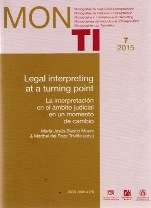Teaching and Research on Legal Interpreting: A Hong Kong Perspective
Main Article Content
Abstract
Downloads
Article Details
The documents contained in these directories are included by the contributing authors as a means to ensure timely dissemination of scholarly and technical work on a non-commercial basis. It is understood that all persons copying this information will adhere to the terms and constraints invoked by each author's copyright. These works may not be reposted without the explicit permission of the copyright holder.
References
Anderson, R. Bruce. (2002) “Perspectives on the role of interpreter.” In: Pöchhacker, Franz & Miriam Shlesinger (eds.) 2002. The Interpreting Studies Reader. London & New York: Routledge, pp. 208-217.
Bell, Allan. (1984) “Language style as audience design.” Language in Society 13:2, pp. 145-204.
Berk-Seligson, Susan. (1990) The Bilingual Courtroom: Court Interpreters in the Judicial Process. Chicago: University of Chicago Press.
Berk-Seligson, Susan. (2002) The Bilingual Courtroom: Court Interpreters in the Judicial Process: with a New Chapter. Chicago: University of Chicago Press.
Chow, Magdalen & Michelle Chin. (1997) “Bad translation could undermine justice, magistrate tells weeping interpreter.” South China Morning Post 30 May, p. 3.
Colin, Joan & Ruth Morris. (1996) Interpreters and the Legal Process. Winchester: Waterside Press.
De Jongh, Elena M. (1992) An Introduction to Court Interpreting: Theory & Practice. Lanham: University Press of America.
Eitel, Ernst Johann. (1877) “Chinese studies and official interpretation in the colony of Hongkong.” The China Review, or Notes & Queries on the Far East 6:1, pp. 1-13.
Fowler,Yvonne; Eva Ng & Malcolm Coulthard. (2012) “Legal interpreting.” In: Millán, Carmen & Francesca Bartrina (eds.) 2012. The Routledge Handbook of Translation Studies. London: Routledge, pp. 417-430.
Gamal, Muhammad. (2006) “Court interpreting.” In: Baker, Mona (ed.) 2006. Routledge Encyclopedia of Translation Studies. London: Routledge, pp. 63-67.
González, Roseanne Dueñas; Victoria F. Vásquez & Holly Mikkelson. (1991) Fundamentals of Court Interpretation: Theory, Policy, and Practice. Durham: Carolina Academic Press.
Hale, Sandra. (2004) The Discourse of Court interpreting: Discourse Practices of the Law, the Witness, and the Interpreter. Amsterdam: John Benjamins.
Hale, Sandra. (2010) “The need to raise the bar: court interpreters as specialized experts.” In: Coulthard, Malcolm & Alison Johnson (eds.) 2010. Routledge Handbook of Forensic Linguistics. Abingdon: Routledge, pp. 440-454.
Hussein, Nadia. M. A. (2011) Legal Interpreting in the Criminal System: An Exploratory Study. Leicester: De Montfort University. PhD thesis. Electronic version available at: https://www.dora.dmu.ac.uk/xmlui/bitstream/handle/2086/4990/Nadia%27s%20Thesis%20%28Revised%29.pdf?sequence=1
Ibrahim, Zubaidah. (2007) “The interpreter as advocate: Malaysian court interpreting as a case in point.” In: Wadensjö, Cecilia; Birgitta Englund Dimitrova & Anna-Lena Nilsson (eds.) 2007. The Critical Link 4: Professionalisation of Interpreting in the Community: Selected Papers from the 4th International Conference on Interpreting in Legal, Health and Social Service Settings, Stockholm, Sweden, 20–23 May 2004. Amsterdam: John Benjamins, pp. 205-213.
Kolm, David. (1999) Taking the Interpreter’s Oath to Heart: An Introduction to the Requirements for Interpreting in Federal Courts. Washington: Federal Judicial Television Network (FJTN).
Kristy, Judith Kenigson. (2009) “Language and Litigation: what judges and attorneys need to know about interpreters in the legal process.” Proteus Newsletter XVIII:4, pp. 3-4.
Lee, Yuk-ming. (1994) The Training of Court Interpreters in Hong Kong. Hong Kong: City Polytechnic of Hong Kong. Unpublished M.A. Thesis. Mikkelson, Holly. (1999) “Training judges and other court personnel.” The Polyglot 29:1, pp. 3-13.
Moser-Mercer, Barbara; Alexander Künzli & Marina Korac. (1998) “Prolonged turns in interpreting: effects on quality, physiological and psychological stress.” Interpreting: International Journal of Research & Practice in Interpreting 3:5, pp. 47-65.
NAJIT. (2007) NAJIT Position Paper: team interpreting in the courtroom. Electronic version available at: http://www.najit.org/publications/Team%20Interpreting_052007.pdf
Ng, Eva. (2013a) The Atypical Bilingual Courtroom: An Exploratory Study of the Interactional Dynamics in Interpreter-mediated Trials in Hong Kong. Birmingham: Aston University. PhD dissertation.
Ng, Eva. (2013b) “Garment, or upper-garment? A matter of interpretation?” International Journal for the Semiotics of Law - Revue internationale de Sémiotique juridique 26:3, pp. 597-613.
Ng, Kwai Hang. (2009) The Common Law in Two Voices: Language, Law, and the Postcolonial Dilemma in Hong Kong. Stanford: Stanford University Press.
O’Barr, William. M. (1982) Linguistic Evidence: Language, Power, and Strategy in the Courtroom. New York: Academic Press.
Ozolins, Uldis & Sandra Hale. (2009) “Quality in interpreting: A shared responsibility.” In: Hale, Sandra; Uldis Ozolins & Ludmila Stern (eds.) 2009. The Critical Link 5: Quality Interpreting – A Shared Responsibility. Amsterdam: John Benjamins, pp. 1-10.
Silverman, David. (2006) Interpreting Qualitative Data: Methods for Analyzing Talk, Text, and Interaction (3rd ed.). London: SAGE Publications.
Sin, King Kui & Joseph S. H. Djung. (1994) “The Court Interpreters’ Office.” In: Gaylord, Mark S. & Harold Traver (eds.) 1994. Introduction to the Hong Kong Criminal Justice System. Hong Kong: Hong Kong University Press, pp. 137-144.
Tiersma, Peter Meijes. (1999) Legal Language. Chicago: University of Chicago Press.
Various authors. (1999) Jury Ordinance. Laws of Hong Kong. § 4(c) (Cap. 3).


